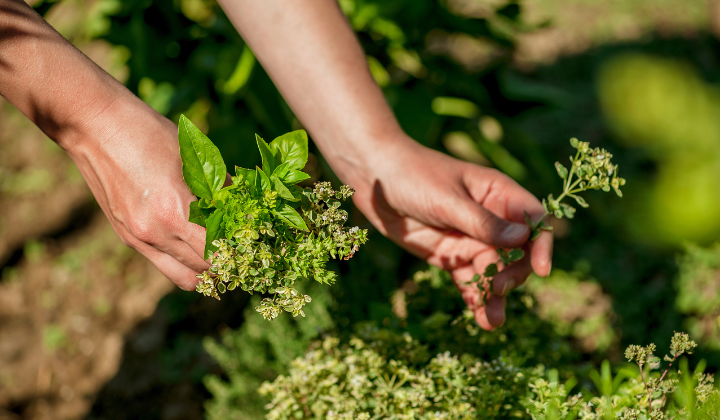
– Manuscript –
Herbs are among the easiest plants you can grow. They only need sunlight, water, and well-draining soil with a neutral pH.
You do not even need a garden. Many herbs, such as rosemary, basil, cilantro, lemon balm, oregano and mint will grow well in containers. In fact, mints should only be grown in containers, unless you do not mind a garden takeover. Mint spreads extremely well.
To get started, test your soil. Buy a pH test online or at your local garden center and follow the directions. A reading of 7.0 is best, but anything between 6.0 and 7.5 is generally acceptable for growing herbs. If the soil tests lower, add garden lime to raise it. If it is too high, add elemental sulfur to lower it. Follow directions on the product about how, and how much, to use.
If growing herbs in containers, use a potting mix meant for edibles. The package label should include information about its pH level.
Choose a site that receives at least six hours of direct sunlight daily. If your garden has sandy or heavy clay soil, use a moderate amount of compost, 15 to 20 centimeters deep, to stabilize drainage. If the soil is always wet, remove the top 15 to 38 centimeters of soil, then add 7.5 centimeters of crushed stone to the bottom of the hole. Combine some compost with the soil you removed and refill the hole with the mix. Create a mound at the top. It will settle lower over time.
If you are using seedlings, follow the directions on the plant tags or seed packet. Some herbs are well-suited for direct sowing into the garden; check seed packets for guidance on spacing your herbs.
Herbs will not grow well in wet conditions, so let the soil dry out a little between waterings.
Herbs also taste better when grown without fertilizer. For this reason, do not overdo the compost when amending the soil to improve drainage. Chervil, summer savory, fennel and lovage are exceptions. They do well with fertilizer.
Annual herbs complete their lives – from seed to senescence, or death – in a single growing season. They include basil, cilantro, dill, chamomile and marjoram.
Perennial herbs, which return for several growing seasons, include rosemary, thyme, sage, tarragon and oregano.
Biennials, like caraway and parsley, live for two growing seasons, producing only leaves during their first year, then flowers and seeds in their second before dying.
However, if they are not strong enough to survive your winters, you may have to treat some listed perennials as annuals.
For the strongest smell, harvest herbs in the morning, after the dew has dried but before the sun gets intense.
Use basil in meals with tomatoes. Add rosemary to chicken, pig and lamb meat. Make tea with the very small flowers of chamomile. Use dill with Greek food, fish meals and cucumbers. Sage and thyme are also great for many kinds of meat. And parsley will freshen your breath when you chew it.
There are some interesting kinds of herbs to seek out, too. Pineapple sage carries the smell of the fruit it’s named for, as do cinnamon and lemon basils, and strawberry and apple mints. There is even a chocolate mint, which is lovely when added to drinks like milkshakes.
Words in This Story
drain – n. to draw off or remove liquid gradually or completely
pH – n. a measure of acidity and alkalinity of a solution
edible – n. something that is suitable or safe to eat
compost – n. a mixture that consists largely of decayed organic matter and is used for fertilizing and conditioning land
amend – v. to change for the better
*This article has been edited and reprinted from VOA Learning English with permission from Voice of America (VOA) for use in English language materials.
